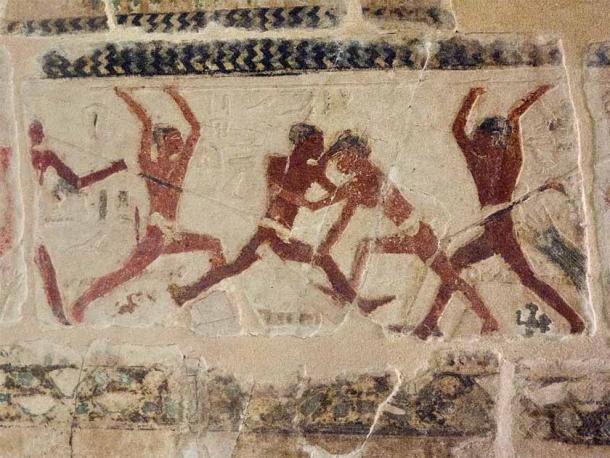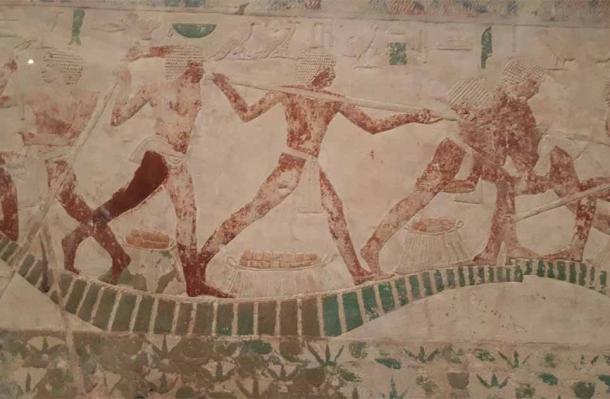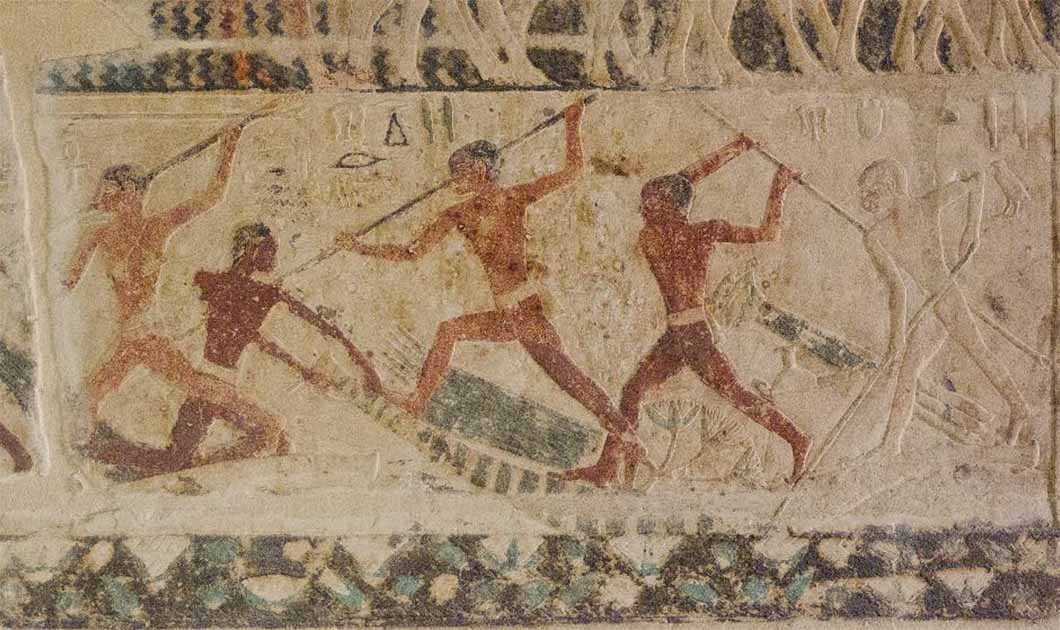Fisherman Jousting: An Ancient Egyptian Sport with a Violent History
Ancient history is full of examples of violence, not only in the form of torture and killings, but also in entertainment and sports. From the bloody gladiatorial combats of ancient Rome, to the Maya ball game, chariot racing in ancient Greece, and Greco-Roman wrestling, ancient history had all kinds of brutal sports. Often these sports were accompanied by crowds yelling in rapture and awe, enjoying the spectacle of blood, guts, and even death.
Ancient Egypt had its own peculiar share of violent sports, in the form of something called ‘Fisherman jousting’ (or ‘Fishermen’s jousting’). It is still practiced today, but in a much more sanitized fashion. Different styles of the fisherman’s joust exist today in France, Germany, Switzerland, Austria, and Belgium - minus the bloodlust.
A Conflict Resolution Mechanism: The Last Man Standing
Records from around 2800 BC show the practice of water jousting was created by the ancient Egyptians to solve disputes and conflicts between individuals or sometimes even entire villages. Men would fight each other with long poles that had razor sharp points at the end, wearing no protection.

Detail of a fisherman jousting scene. Ny-ankh-nesuwt tomb relief, Saqqara, Old Kingdom, early 6th Dynasty, c. 2345-2320 BC - Nelson-Atkins Museum of Art. (Public Domain)
The objective of the “game” of Fishermen’s jousting was to knock one’s opponents into the Nile River from their papyrus reed boats. The pain caused by a hit from the pole was not the end of it – most men couldn’t swim and would drown. The ones who could swim had to combat the dual threat of ravenous crocodiles and hippopotamuses that lurked underneath the surface and would most definitely chomp them to death.
This aquatic combat sport has been depicted on several ancient Egyptian tomb reliefs, like the famous one at Saqqara (from the early 6th Dynasty, c. 2345–2320 BC). It shows two vessels with a small group of men on either side, with some of them maneuvering the boat and the others using their poles to knock opponents off of their respective boats, whilst standing upright.
- Egypt’s Ancient Tahtib Martial Arts Form: Stick Fighting Warriors!
- Boats, Bowling and Moldy Bread: Curious Achievements Ancient Egypt Shared With the World
Was Fisherman jousting a Sport or a Conflict Settler?
There is still debate whether these reliefs depict a sport or a violent conflict. In ‘Sports: The Last Five Millenia’, historian Allan Gutman writes the following,
“There is no doubt, however, about the competitiveness of a seasonal aquatic sport that German scholars know as Fischerstechen ("fishermen's jousting"). Numerous paintings show boatmen (who are probably not fishermen) bringing in the harvest from the fertile delta of the Nile. While some use poles to propel their boats forward, others use their poles to strike the crewmen of the other boats, tumbling them into the shallow water.”
Guttman’s suggestion here is that while the spirit of this exchange was competitive and sporting, it was probably conducted by boatmen, and not fishermen. Bringing in the harvest in ancient Egypt, like any other civilization, contemporary or from the past, was a community ritual, and some sort of conflict developed in deciding how to share it.

Depiction of fishermen jousting in the Mastaba tomb of Niankhkhnum and Khnumhotep, Saqqara, Egypt. (kairoinfo4u / CC BY-NC-SA 2.0)
How did this seasonal, harvest exchange develop into an aquatic sport that is so widely celebrated today in its modern avatar? Clearly the sport travelled from Egypt to ancient Greece after Alexander’s conquest in 332 BC, and eventually to the Romans.
“In the Hellenistic period, after the conquest of Egypt by Alexander the Great, ethnically Greek Egyptian athletes participated in the Olympic Games and in local festivals like the Basileia in Alexandria. In Roman times, the emperor Hadrian—known for his philhellenism—founded Greek-style athletic 130 A.D. Participants in these games were as ethnically diverse as the polyglot Roman empire,” writes Peter Piccione in ‘ Sports and Games, Pharaonic Egypt’.
- The Nile: How One River Helped Build a Civilization – 10 Amazing Facts
- Romans Drank Gladiator Blood as an Epilepsy Cure!
He has an interesting take on this exchange, which is also linked to another important ritual - death. Studying jousting from the tombs of the 5th-12th Dynasties, he observed that two teams of “papyrus skiffs” would attack each other, both crews involved with their poles and oars. The goal was to overturn the rival boat, but it was not a violent conflict.
Rather, it was a ritualized funerary battle, with the goal being to convey food and water lilies to the tombs. The defenders would attempt to prevent delivery, while the attackers would attempt to go through with the offerings. In fact, the boatmen were actually ka-priests, while the deceased is represented on the tomb as the receiver of the offerings, often as a spectator.

Detail of fishermen jousting at the Egyptian Museum. (© Alicia McDermott)
Water Jousting: A Modern Avatar
The sport or the ritual appeared in western Europe sometime around the 6th century BC (570 BC, for example, in France), but it not till the late medieval period that it gained popularity. Crusaders leaving for war would practice jousting as a teambuilding exercise. French kings and queens were entertained with water jousting ( joutes nautiques) competitions particularly along the Saône River in Lyon.
It was only a matter of time before the infectiousness of this sport spread across the English Channel. Reportedly, Queen Elizabeth I was received at Sandwich with a spectacle of water jousting. Soon, local arenas would be flooded by people clamoring to get a glimpse of the competition. It soon became ingrained in the local culture, where water jousting started taking place to inaugurate maritime ports by the middle of the 17th century.
Many medieval traditions are still carried on, most critically the blue team comprising entirely of bachelors and the red team of married men. Compared to its origins, the sport is now fairly sanitized – each boat has a jouster and 10 oarsmen, and a drummer and an oboist to play medieval tunes according to the rhythm of the rowing.

Joutes nautiques (water jousting) in La Rochelle. (Jebulon / CC BY-SA 3.0)
The jouster wears white and a wooden breastplate, with a 2.8-meter (9.19 foot) long wooden lance, with a 70 cm (27.56 inch) shield called pavoir. He stands on a 3-meter tall (9.84 foot) wooden platform on the front of the boat. Once the two boats charge towards each other, the jouster to fall first loses and has to go into the river. This is quite a distinct break from the dangerous Nile river of the past, with crocs and hippos lying in wait!
Top image: Depiction of fishermen jousting in the Mastaba tomb of Niankhkhnum and Khnumhotep, Saqqara, Egypt. Source: kairoinfo4u / CC BY-NC-SA 2.0
By Sahir Pandey
References
HFH. 2018. Egyptian Fisherman Jousting (Water Jousting). Available at: https://healthandfitnesshistory.com/ancient-sports/egyptian-fisherman-jousting-water-jousting/.
GFTG. 2017. The Fisherman’s Joust. Available at: https://www.goforthegame.com/blog/2017/9/25/the-fishermans-joust.
Grimes, A.C. 2021. THE MOST INTENSE SPORTS OF THE ANCIENT WORLD. Available at: https://www.grunge.com/147544/the-most-intense-sports-of-the-ancient-world/.
Guttman, A. 2004. Sports: The First Five Millenia. University of Massachusetts Press.
Piccione, P. 2012. Sports and games, Pharaonic Egypt. Available at: 10.1002/9781444338386.wbeah15167.
Preskar, P. 2021. 7 Most Brutal Sports in History. Available at: https://historyofyesterday.com/7-most-brutal-sports-in-history-c1137dbb0584.
SMR. 2021. Water Jousting in Séte – France’s Medieval Sport Tradition. Available at: https://stickymangorice.com/2021/08/17/water-jousting-in-france/.




















Comments
It’s a stretch.
Nobody gets paid to tell the truth.